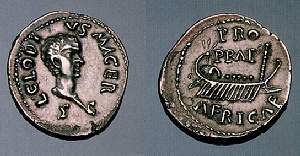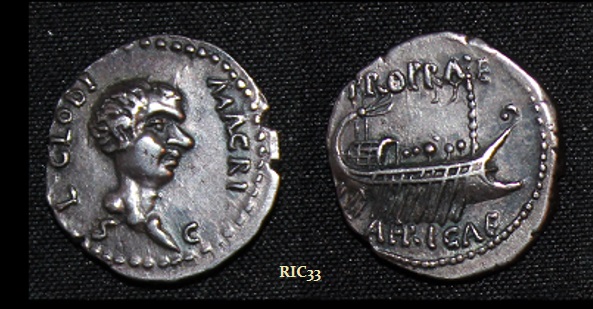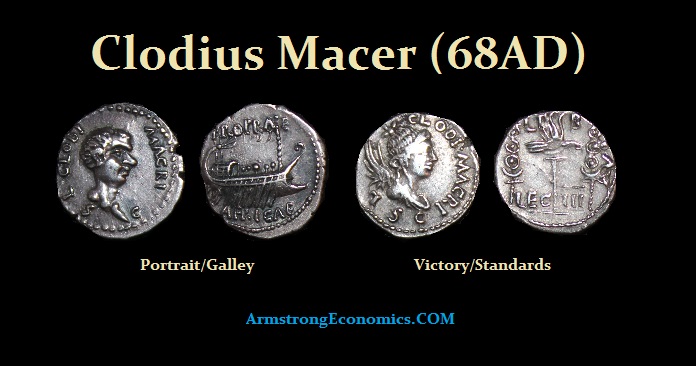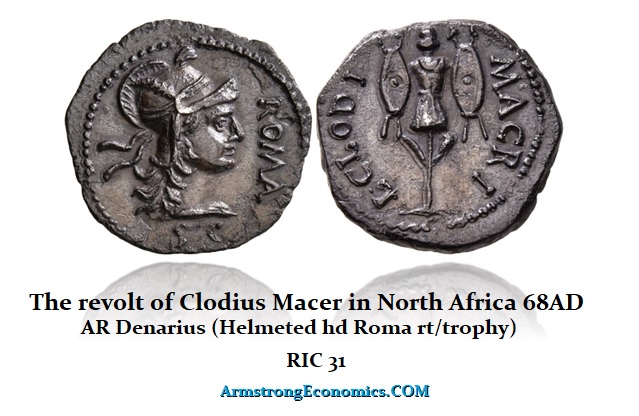Clodius Macer
Clodius Macer was the Pro Praetor in Africa at the time of Nero’s fall. Initially, Clodius is said to have been little more than a pirate who raided the North African coast. Clodius attempted to broaden his power base by cutting into the grain supplies from Africa to Rome. By April of 68 AD, Clodius decided against supporting Galba in his bid for the throne. By June, when Nero died, Clodius began striking coins in his name and portrait. By October, Galba had solidified his power in Rome and ordered the of Clodius Macer.
The revolt of Clodius Macer in North Africa gave further momentum to the downfall of Nero, who had survived the uprising of Vindex in Gaul and was dealing with Galba’s more formidable challenge from Spain. It was clear from the outset that Galba had intended to replace Nero as emperor, yet that may not have been the professed goal of Clodius Macer.
One remarkable aspect of his coinage was the use of S.C. (Senatus Consulto) on denarii. That inscription otherwise had not been used on Roman silver coins since about 40 BC, and its presence was meaningful insofar as being sanctioned by the Senate of Rome. Additionally, his portrait coins show him bareheaded without any laurel wreath. One would imply that he was not seeking to replace Nero as emperor. Macer’s coinage, perhaps, was to assure the senate that his revolt was to restore the Republic.
While his revolutionary contemporaries’ coins are usually restricted to the themes of victory, unity, and recovery, most of Macer’s issues are restorative, recalling the battle of Actium in 31 BC, which began the entire Imperial Era with Augustus defeating Mark Antony and Cleopatra. Perhaps he was suggesting that the war was to eliminate emperors, or perhaps it was just a revolution being waged in the centenary year of Actium.
The legionary denarii that Marc Antony struck for the battle of Actium were still in circulation. It was one of the largest productions in Roman history. Such coins were still found in circulation in Pompeii, which was destroyed by the volcano about ten years later. Macer adopted both of Antony’s designs which included the image of the galley as a reverse type for his portrait denarii and the legionary eagle-and-standards in combination with four obverse types – the heads of Africa and a lion, the bust of Victory, and the standing figure of Libertas.

Macer also followed the arrangement of the inscriptions on Antony’s legionary coins. The war galley design was accompanied by Antony’s personal inscriptions, and with Macer’s restoration, it bore a personal inscription that identified him as the legatus Augusti propraetore of Africa. Antony’s eagle-and-standards reverse named various legions, and specialized units; Macer followed suit by naming the two legions under his control, the Legion I Macriana and the Legion III Augusta. He had raised the former in the course of his rebellion and had originally commanded the latter in Numidia.
Monetary System
The Coinage of Clodius Macer is clearly of a different style than the coinage normally issued from Rome. The styles are certainly more barbaric in execution, indicating that the skilled labor for die-cutting tended to reside mostly in Rome. All of Macer’s coins are extremely rare, with fewer than 85 coins of all types known, of which fewer than 20 are portrait types.
Mints: Unknown, probably local North Africa
DENOMINATIONS
AR Denarius portrait (3.6 grms)
AR Denarius Lion, Victory, Africa, Roma, Liberty or female of Carthage








